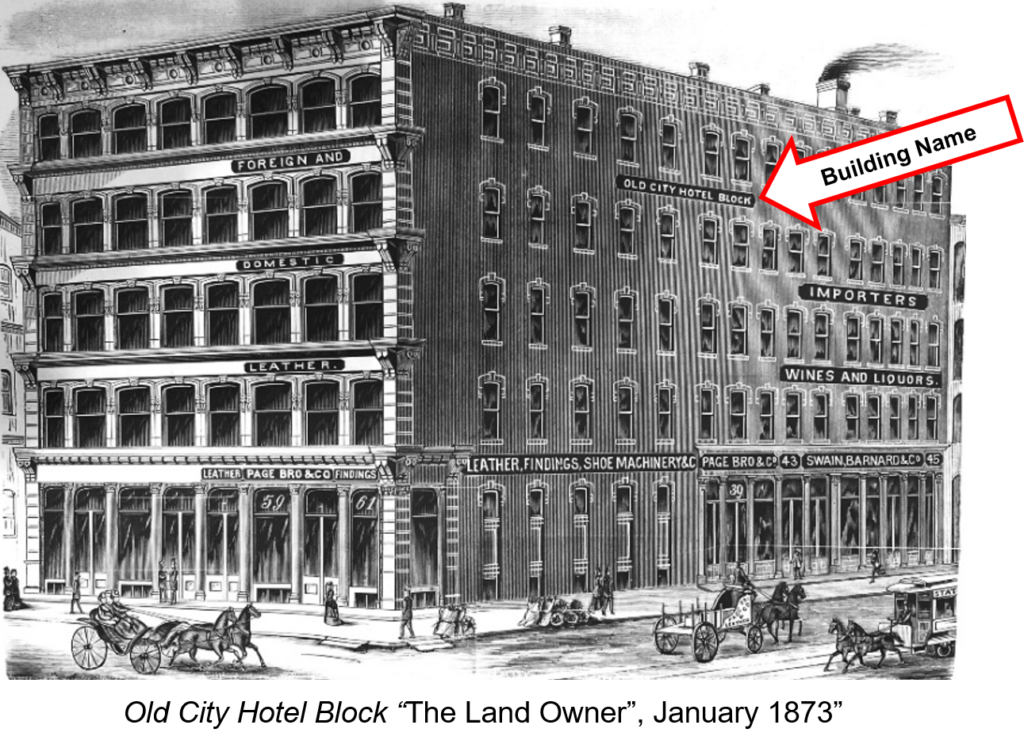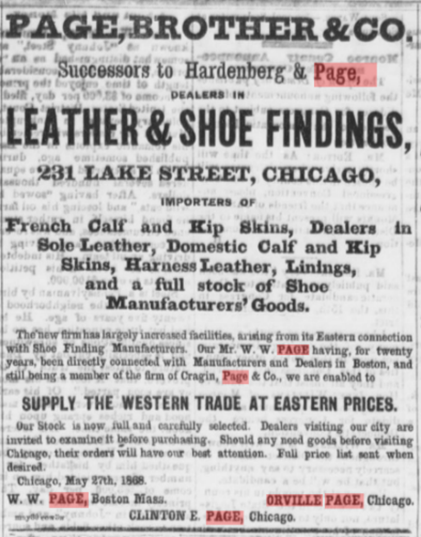By Brian Kelly, Class of 2019

The allure of Chicago’s few remaining post-fire buildings increases with each passing year. On Chicago Architecture: A Walk Through Time tours, I hand a large red magnet to a willing apprentice and ask them to hold it up to the building. The unique iron façade grabs the magnet to the amazement of all! That is the attraction of the Page Brothers Building.
So, who were the Page Brothers? William W., Orville, and Clinton Page were shoe findings and leather merchants.
Each corner on State Street offers a compelling story to tell, and the south east corner of State and Lake does not disappoint. First, we need to hop into the “Way Back” machine, return to the mid-1830s and meet a Chicago Founder.
Stiles Burton
Say hello to Stiles Burton! Stiles arrived in Chicago from Connecticut in May, 1836. He leased a space on Lake Street, Chicago’s mercantile district, between Clark and Wells and opened a lucrative grocery and liquor store. Stiles was known to “have fitted out many of the smacks and luggers (fishing boats) that plied the lake.”

On November 1, 1839, Stiles purchased a land patent for the property on the south east corner of State and Lake from the U.S. government. Until then, the parcel was on the west edge of the Fort Dearborn Military Reservation. Burton quickly erected a wooden “balloon-frame” building to house a hotel, saloon, and grocery/liquor store.
Stiles Burton is considered Chicago’s first retailer on the east side of State Street.
Stiles married Ann W. Germain in 1844. Together they would raise a family of three, two boys and a girl. Their first home was located on Randolph Street across from Dearborn Park, now the Chicago Cultural Center. As the family grew, the Burtons required a larger home and moved south to Michigan Avenue at Congress Street (now Ida B Wells Drive).
In 1848, Stiles improved his State and Lake property when he constructed “the grand building of 1848”. Red brick and four stories high, The City Hotel was located on Lake Street with easy access for out-of-town customers of merchant wholesalers. It was equally popular with the local citizenry who selected the hotel for a variety of events. This corner of State and Lake became a cherished Chicago landmark.
Burton, “thrifty, economical and energetic”, leased the hotel and operated the highly profitable saloon and grocery/ liquor store. As Stiles amassed wealth, he invested in “large interests in Chicago real estate.”
In 1871 the Fire took the building. Burton commissioned John Van Osdel to design anew and build out quickly. Which explains the fancy, albeit out of date, and combustible iron façade on Lake Street.
The initial design direction was to “retain and perpetuate the old-time associations of the ‘Stiles Burton Corner’ by enlarging the Hotel for businessmen visiting the city.” However, Chicago’s lodging business had evolved, and Stiles saw a new opportunity for his land; retail. The “Old City Hotel Block” rose as a mercantile structure with both Lake Street and State Street frontages. It opened in 1872 with two prime tenants: Page Bro. & Co. on Lake and Swain, Barnard & Co., a high end liquor store, on State.

Page Bro. & Co.
The three Page Brothers: William W., Orville, and Clinton E. hailed from Canton, New York, upstate close to the St. Lawrence River.
William W. made his way to Boston and became a partner at Cragin, Page & Co., an established Boston firm. The wholesaler outfitted shoe manufacturers with skins, sole leather, laces, and tools, also known as “findings,” the basic elements of shoe manufacture.
Orville Page first appeared in Chicago directories and display ads in 1865 as Secretary of Travelers’ Insurance Company. In 1867, Orville, bought into an existing shoe findings wholesaler, Hardenberg. A year later, the firm filed for bankruptcy and reemerged as Page, Brother & Co. located off the beaten path at 231 Lake Street, west of Franklin. Brother Clinton joined the firm.

The Page, Bro. & Co. store had relocated twice when they announced on December 4, 1872, their new store location at “Old City Hotel Corner”.

According to “The Inter Ocean,” Page, Bro. & Co. declared bankruptcy on April 23, 1875. Throughout 1876, the Pages were in and out of bankruptcy court. In 1877, Orville Page sued his brother and partner William to protect assets and account ledgers; Judge Moore found in his favor. By November, 1877, the jig is up for Page Bro. & Co. as it moved into receivership. Their time on ‘Stiles Burton Corner’ was less than 5 years.
Meanwhile, the Stiles Burton clan was busy. Weddings and births enlarged the family. One of Chicago’s remaining “old settlers”, Stiles Burton passed on January 14, 1875. The estate of Stiles Burton was divided among his heirs in 1897. They were eldest son Le Grand, daughter Virginia B. Holmes, and the children of deceased son S. Lester Burton, Sophia and Robert.
The real estate portfolio included prime properties located on Michigan and Wabash Avenues, State, Lake, and Dearborn Streets. The “Old City Hotel” property fronted 180 feet on State and 70 feet on Lake. S. Lester Burton’s children and Virginia B. Holmes divided it two thirds and one third respectively.

While a sixth floor was added to the entire structure, the subdivision of the property ownership is the reason the northern portion’s façade was remodeled in 1902. The remodeled structure was named the “Loop End Building” in recognition of its location at the end of the State Street cable car line. The southern portion was sold in 1900 and eventually became The Chicago Theater.
Why the Page Brothers Building?
In the beginning of the North Loop Redevelopment Plan, in early 1970s, it became apparent that several buildings of historic and or architectural significance were not protected by landmark status. Two of those were the Chicago Theater and the Loop End building.

The above plan was included in the City of Chicago materials held by the Chicago Public Library. As you can see, the building was renamed.
My hunch is the inspiration for the new name was the 1873 lithograph” that features the “Page, Bro. & Co.” sign on the Lake and State Street façades.

Further, the words “Loop End” are not the most appropriate to promote the redevelopment of the North Loop and its promise of a bright future.
Sometimes life is serendipitous. Long live the Page Brothers!


Better the bankrupt Page Bros than Chick-fil-A?
Brian … nIce investigation and explanation.
Thanks Tom. Always fun reading about the Founders.
Thanks for sharing your research.
That was such a fun read. Thank you for pulling it together for us. Cool magnet example.
Thanks Joan. Found the magnet online. An easy gimmick that surprises and delights.
Nice info for a building that doesn’t usually get much discussion thanks
Thanks Eileen. One of those things that are easily passed by. It was the impact of Fort Dearborn on the development of the city that got my attention. Why Dearborn, Clark and LaSalle took the overflow from Lake Street.
Thank you for researching and pulling together such detailed information, Brian. I especially liked the very clear captions and notes on the photos. Great job!
Thanks Erica. Sometimes that little bits get by if not highlighted.
You are welcome, David!